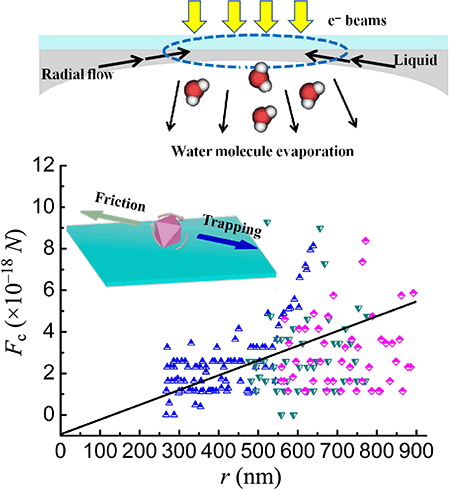Nano Research ( IF 9.9 ) Pub Date : 2018-04-05 , DOI: 10.1007/s12274-018-2052-6 Chang Li , Xin Chen , Haiyang Liu , Jiali Fang , Xiaoqin Zhou
The dynamic behavior of octahedral gold nanoparticles (NPs) and nanoparticle clusters (NPCs) in aqueous solution is studied by in-situ liquid-cell transmission electron microscopy (TEM). The octahedral Au NPs/NPCs show preferential orientations in the liquid cell, due to the interaction with the SiNx window. The Au NPs show long-range reversible hopping and three-dimensional (3D) rotational motions in the liquid environment. At the same time, the Au NPCs and NPs perform slow stick-slip and stick-roll motions, respectively, with a centripetal trend. The centripetal motions were explained by a liquid evaporation-induced radial flow model, in which the NPCs/NPs trajectories are controlled by Stokes forces and surface friction by the silicon nitride window. The calculated radius-dependent force (Fc) on the NPCs/NPs shows a semi-linear correlation with the distance r between the NPCs/NPs and the center of mass, accompanied with stochastic fluctuations, in agreement with the model predictions. This work thus demonstrates the effectiveness of in situ liquid-cell TEM for the in-depth understanding of complicated liquid flow and force interactions in nanomaterials.

中文翻译:

通过原位液体细胞透射电子显微镜(TEM)研究了八面体金纳米颗粒(NPs)和纳米颗粒簇(NPC)在水溶液中的动力学行为。由于与SiN x的相互作用,八面金Au NPs / NPCs在液池中显示出优先取向窗户。Au NP在液体环境中显示出长程可逆跳变和三维(3D)旋转运动。同时,Au NPC和NP分别执行缓慢的粘滑运动和粘滑运动,并具有向心趋势。向心运动由液体蒸发引起的径向流模型解释,其中NPCs / NPs的轨迹由斯托克斯力控制,而表面摩擦由氮化硅窗口控制。计算得出的NPC / NP上的半径相关力(F c)与距离r呈半线性关系NPC / NP与质心之间的距离,伴随着随机波动,与模型预测一致。因此,这项工作证明了原位液细胞TEM对于深入了解纳米材料中复杂的液体流动和力相互作用的有效性。


























 京公网安备 11010802027423号
京公网安备 11010802027423号